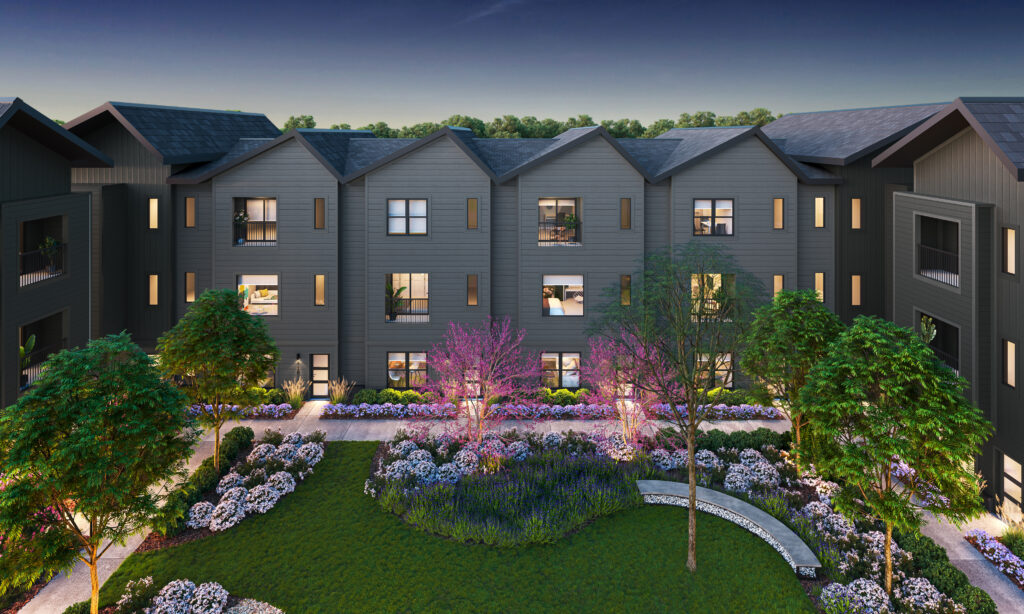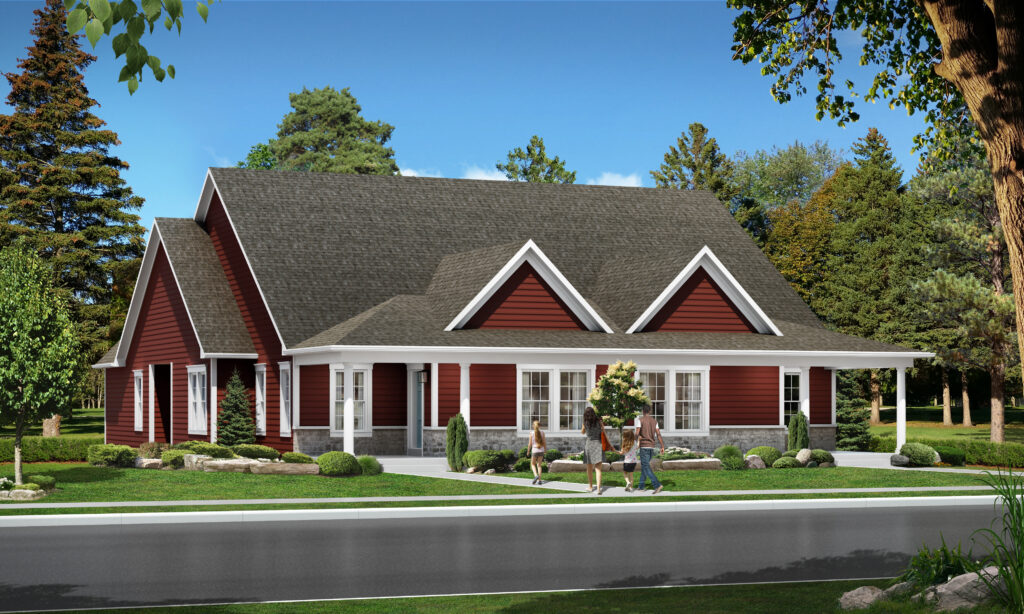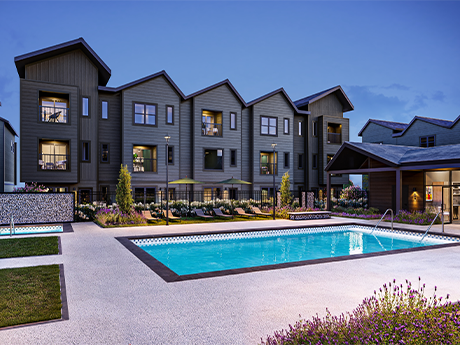Empty nesters and millennials with children are increasingly drawn to new subdivisions of build-to-rent (BTR) houses for lifestyle and financial reasons. These professionally managed BTR homes come in many shapes and sizes.
For a growing family, a new three- or four-bedroom rental house might be the ideal fit. Renters who don’t need a lot of space, but who value private parking and a modest backyard, can move into a one- or two-bedroom cottage-style home.
These properties provide more living space and privacy than a typical apartment and at a more affordable cost than a for-sale home.
New BTR developments of single-family rental (SFR) homes are finding renters in every region of the country. Developers define “BTR” in different ways, but all of them create new subdivisions of single-family homes offered as rentals.
Urban Townhouses Draw Families
In April, workers finished the first units at Oxenfree at WeHo, a new development of SFR townhouses in the Wedgewood-Houston neighborhood of Nashville. In May, the paint was finally dry on the model unit. By the beginning of June, work had finished on 10 new single-family townhouses.
In the past month, Oxenfree has hosted nearly 50 in-person tours and recorded more than 57,000 website visits.
“There’s nothing else like it,” says Cliff Payne, chief investment officer of build-to-rent for Chicago-based Core Spaces. “You can’t rent a three-bedroom townhome with our level of amenities and on-site management anywhere else in this vicinity.”
The 96 townhouses range from three-bedroom homes with 1,390 square feet to four-bedroom homes with as much as 1,870 square feet of space. Rents start at $3,150 a month.
Within the city limits of Nashville, the new development is in a neighborhood of art galleries and loft spaces, just a few minutes away from downtown by car. The high cost of land required a densely packed development. Core Spaces bought the site from a local homebuilder who had already begun the entitlement process and divided the site into the individual lots beneath the 96 townhomes.
Oxenfree squeezes its 96 townhouses onto six acres. That works out to about 16 units per acre. It’s more densely developed than most SFR developments, even developments of cottage-style homes where the individual units have much less space.
The townhouses at Oxenfree line an old-fashioned street grid, with garden-like amenity spaces in the middle of the block, including a pool and grill areas. The townhouses don’t include private yards, but they do provide attached garages. On-site maintenance is another major amenity for the residents. There’s also a 1,400-square-foot clubhouse for residents.
“The amenities are a big reason people are choosing to live in our community versus one of those scattered, single-family, one-off rental homes,” says Payne.
About a third of the likely renters at Oxenfree are young professionals or families who can’t afford to buy a single-family house.
Another third of the residents are likely to be people who have to rent because of a transitory situation in their lives, such as a short-term job or a recent divorce. The remaining third are likely to be older people who have sold a home and now prefer to rent.
“Home prices remain elevated, and interest rates are quite high, so to rent in our communities is a significant discount to otherwise purchasing a home,” explains Payne.

Living the Single Life in a Cottage
Renters are rushing to sign leases at a new development of rental cottage-style homes on the western edge of the Phoenix metro area.
Work is nearly complete on the last homes at Cottages at McDowell, a new community in Avondale, a suburb of Phoenix, Arizona. These detached cottage-style homes are leasing almost as quickly as work crews can finish planting the landscaping in their small, private backyards.
“It’s leasing about one unit a day, about 30 units per month,” says Todd Wood, CEO of Christopher Todd Communities, based in Mesa, Arizona.
That’s a fast lease-up, especially considering that Phoenix has become one of the most overbuilt markets in the United States for rental housing. Thousands of new apartments drove apartment rents down more than 3 percent in the past 12 months. The occupancy rate in Phoenix in May was 92.9 percent, according to RealPage. That’s down from 95.7 percent two years ago.
Christopher Todd’s cottage-style homes compete directly with Class-A apartments for renters. “The demographics are the same,” says Wood.
About 65 percent of Christopher Todd’s residents are under the age of 35, similar to most apartment communities. The remaining residents are a mix of empty nesters, divorcees and others. About two-thirds of the residents are single. More than two-thirds (70 percent) have pets.
For Christopher Todd’s residents, their most important amenity is the single-story, detached home itself and the private backyard.
“The No. 1 complaint that people have in multifamily living is noise — people living above them, below them and to the sides,” says Wood.
Christopher Todd’s cottage-style homes make room for this kind of privacy, even though the communities squeeze in about 12 units per acre. The homes range from one-bedroom units with about 650 square feet of space to two-bedroom units spanning 950 square feet. Each home also includes a covered parking space and a private yard with 300 to 750 square feet of space. The cottage-style homes rent for an average of $225 a month more than comparable apartments, says Wood.
“That gives renters a choice that they wouldn’t have otherwise,” says Wood. “We can lease up faster and give away fewer concessions than a normal multifamily vertical environment.”
Christopher Todd now has nine BTR projects in Phoenix alone.
“This product was just so very welcomed by the consumer,” says Wood. “There’s just nothing out there like it.”
Families Pay a Premium for More Space
This May, leasing agents conducted more than 30 in-person tours a week of the large, new SFR houses at Bluebonnet Trails, a subdivision of 125 houses that’s sprouted up in Arlington, Texas, a suburb in the middle of the Dallas-Fort Worth metro area.
“That’s very good traction for a property of this size,” says Andrew Schaffler, chief investment officer for Oakland, California-based Roofstock, an investment platform and data firm focused on the SFR business.
The company manages about 25,000 rental houses across the United States and has brought equity to several BTR developments through its platform. But Roofstock defines BTR differently than the communities of one- and two-bedroom rental cottage-style homes built by companies like Christopher Todd.
Roofstock concentrates on larger townhomes and detached single-family houses with three or four bedrooms apiece. They are about twice the size of a typical rental cottage-style home.
The smallest townhouses at Bluebonnet Trails have 1,445 square feet of space and two bedrooms. The largest have 1,721 square feet and four bedrooms. Rents start at $2,685 a month.
The 44-acre site at Bluebonnet Trails is also relatively lightly developed. That works out to a little more than three units per acre, including a substantial dog park and open space with more than three acres. The community does not include a clubhouse. There’s no fitness center.
The larger floor plans appeal to families with children as well as a number of empty nesters who are not yet ready to give up the ample living space they have become accustomed to, says Schaffler. “Your renter demographic is typically totally different than multifamily.”
Across the United States, developers have built about 1,600 new subdivisions of SFR houses including townhomes, cottages and larger, detached single-family houses, according to the research division of Roofstock. That adds up to about 200,000 units of clustered, SFR housing.
About half of those rental homes are in communities comprised of one-bedroom and two-bedroom houses, including clusters of cottage-style homes. Roofstock classifies these properties as “horizontal multifamily” properties because they tend to compete for the same renters as apartment communities.
About 94 percent of these horizontal multifamily units were occupied as of May, says Schaffler. That’s about the same as the multifamily occupancy rate nationally, according to RealPage.
Average rents fell by more than 2 percent in 2023 for these one- and two-bedroom BTR properties and fell by another 1 percent in the first half of 2024, according to Roofstock. Once again, many apartment communities have been forced to lower their effective rents to compete with hundreds of thousands of new apartments now opening.
The other half of the 1,600 SFR projects analyzed by Roofstock are subdivisions of larger rental houses, including mostly three and four-bedroom townhomes and single-family homes. Many young families might prefer to buy a single-family house, but high interest rates and home prices limit what they can afford. In addition, many lenders are requiring large down payments and high credit scores from prospective homebuyers.
About 96 percent of the units at these communities of three- and four-bedroom rental homes were occupied as of May, according to Roofstock. Rents were flat in 2023 and rose more than 2 percent in the first half of 2024.
Developers of rental homes hope to attract the giant millennial generation as they age into their 30s and need a little more living space and privacy.

The More Bedrooms, The Better
Eager renters signed leases for 13 new rental townhomes in April and another 12 in May at Home at Ashcroft, a 178-unit BTR community in Oswego, Illinois, a suburb on the western edge of the Chicago metro area.
The leasing office at Ashcroft was especially busy as the end of the school year approached. In contrast, the leasing team executed seven or eight leases a month on average during the fall and winter. “People take a long time to move when school starts,” says Anthony Tiritilli, president of development for Lynd, headquartered in San Antonio, Texas.
The families who move into three- and four-bedroom SFRs often make several visits to the property before signing a lease, especially during the school year.
“Your lease-ups are going to be a little more protracted than multifamily,” says Tiritilli. That’s because families that need the space provided by three or four bedrooms tend to lead more complicated lives and have more furniture that complicates their decision to move.
These residents also tend to stay two or three times as long as tenants in apartment complexes. The average apartment renter might stay 1.5 years compared with more than three years for a BTR tenant. “The average BTR stay is way longer,” says Tiritilli. That has a huge benefit for BTR property managers who have to spend much less on turnover costs.
Ranch and two-story floor plans range from 1,559 to 1,747 square feet at Home at Ashcroft. Each home features its own two-car garage, fenced-in yard and private back porch. Rents start at $2,591 per month.
The SFR townhouses are attached in groupings of four and six. At a glance, these sets of townhomes look like very large, single-family houses arranged along the curving streets of a typical new subdivision. It takes a minute to notice the multiple driveways and garage doors.
“The more we can make it feel like a real single-family home, the more pricing power we have and the more success we’re going to have,” says Tiritilli.
The housing is much more densely developed than meets the eye, with 12 units per acre surrounding a suburban-style retention pond with a fountain.
The site plan was created by an earlier developer who had planned a community of for-sale townhouses. Many SFR developers like Lynd partner with local home builders who have already divided the site into separate properties so that each house has its own property tax bill and its own deed.
The community will also include a 7,000-square-foot, $2 million clubhouse with a fitness center, an outdoor pool and firepits.
The community is Lynd’s second BTR project in the Chicago metro area. The first was a development of 36 townhouses in Willow Springs, another western suburb of Chicago. Lynd operates approximately 20,000 units in 13 states.
“There’s nothing like this,” says Tiritilli. “We said, ‘They’re going to fly off the shelf.’ And that’s exactly what they did.”
Developer’s Value Proposition: More Space
The first homes opened in late 2023 at Eden Hill, a development of new rental houses in Dover, Delaware. Within six months, 50 homes were rented out, and another 25 had received their certificate of occupancy.
“We are approaching 50 percent completion,” says Patrick Duffy, founder and CEO of Chatham Bay, a development company based in Wilmington, Delaware. The houses at Eden Hill have been renting as quickly as the developer arranges the building permits and completes construction.
Eden Hill fills a gap in the local housing market for larger rental units. The project will eventually feature a total of 155 rental houses, including a mix of standalone detached houses and duplex homes with a mix of one and two stories. Each will have three or four bedrooms.
A three-bedroom home at Eden Hill costs about $2,000 a month in rent for approximately 1,700 square feet of space, says Duffy. That works out to about $1.30 per square foot, which is a good value in the apartment market around Dover. Eden Hill also includes a 6,000-square-foot clubhouse with amenities like a plunge pool and a fitness center.
Roughly the same $2,000 a month would only be enough to pay the rent on a smaller, 1,350-square foot apartment with two or three bedrooms at a community “that may or may not have new amenities,” according to Duffy.
“We’ve never built two bedrooms because it never made sense from a competitive standpoint in our markets,” says Duffy. “Our value proposition is more space and perhaps an extra bedroom and dedicated recreational space like a backyard.”
Three- and four-bedroom rental housing is an underserved market, says Duffy. “Most of those garden apartments are one and two bedrooms.”
Chatham also focuses on delivering three- and four-bedroom apartment homes to give itself more options in the event the company decides to exit these investments. Three- and four-bedroom houses could potentially be sold to individual buyers. Each of these rental units will be on its own lot.
“When you build two-bedroom units, you’re going to be very limited as to who is going to buy that type of unit,” says Duffy. “It’s highly likely that we would hold this forever.”
Chatham Hill has been investing in rental houses for more than 20 years. After the housing crash and the global financial crisis of 2007 to 2009, the firm began to develop whole communities of SFR houses.
The company now owns and manages approximately 12 BTR communities totaling about 1,200 units. Chatham’s portfolio, including “scattered-site” SFR houses not located in subdivisions of other rental houses, totals 20,000 units.
Duffy is optimistic about the business. “It’s only going in one direction it seems, and that’s up,” says Duffy. “There’s still only a fraction of the SFR houses in the U.S. that are professionally managed.”
By Bendix Anderson. This article originally appeared in the May/June issues of Multifamily & Affordable Housing Business.


